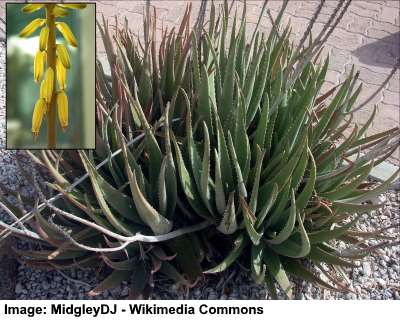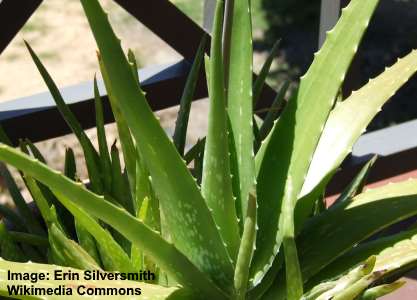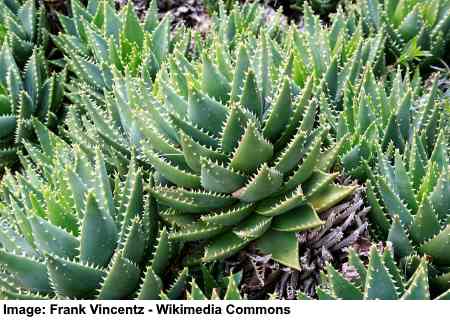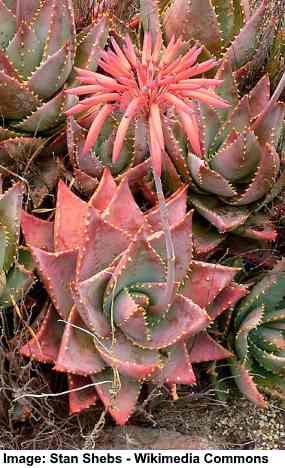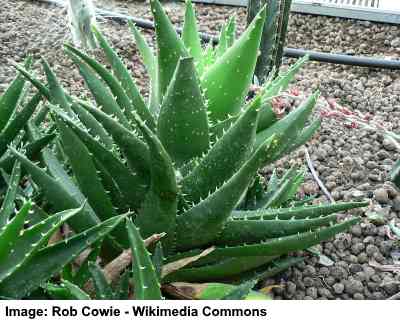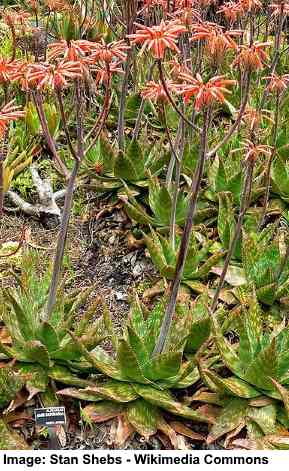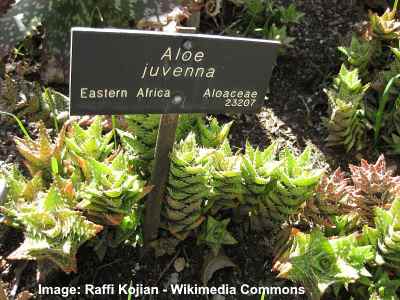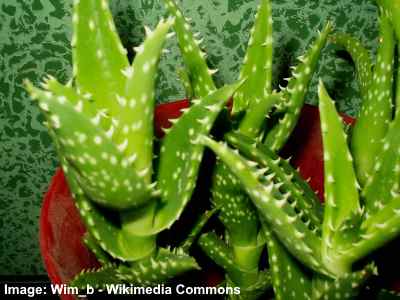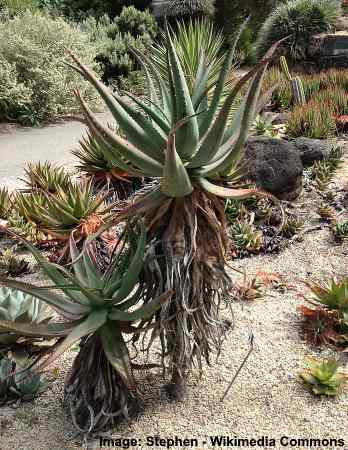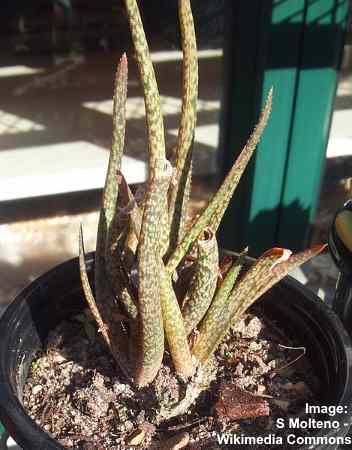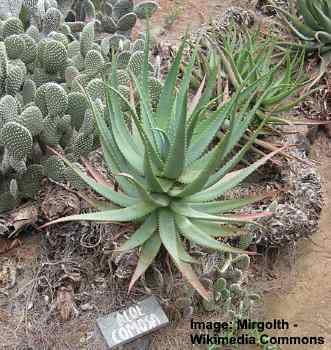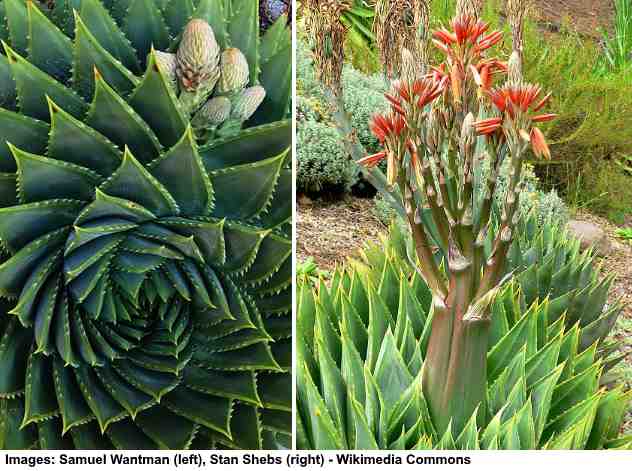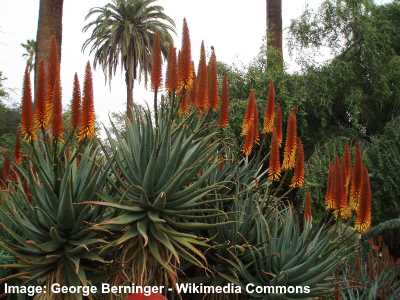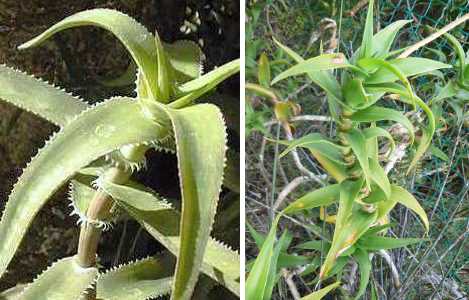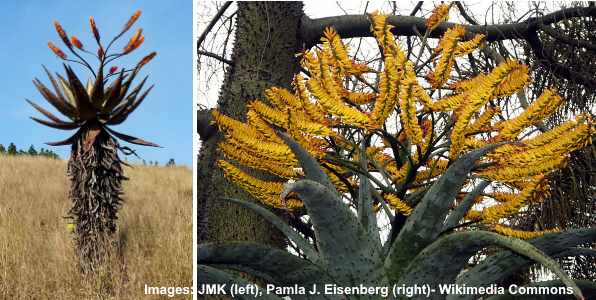Types of Aloe Plants: Amazing Varieties of Aloe (Vera) Plants (With Pictures and Names)

There are many types of aloe plants, with Aloe Vera being the most common. Most varieties of aloe plants have thick fleshy leaves that contain a gel-like substance. Although aloe species with green leaves are the most common variety, there are also types of red-leaved aloes, golden aloes, and orange aloe plants.
Aloes are a type of flowering succulent, and there are over 500 plants belonging to the Aloe species. When they flower, aloe plants produce striking red, orange, yellow, or pink flowers. (1, 2)
Many types of aloe grow and thrive outdoors in hot dry conditions. Aloe vera also makes a good houseplant because of its medicinal uses. Because some types of aloe plants can be toxic, it’s important that you have a true aloe vera variety if you want to use the healing gel from the leaf.
In this article, you will find out about the many different types of aloe plants (with pictures for easy identification). You will also find out about the best kinds of aloes to use for their color and interesting features.
Aloe Vera Propagation
The best way to propagate an Aloe Vera plant is using its offshoots (also called pups or baby aloe plants).
Aloe offshoots (pups) are baby plants that are still connected to the main mother plant. Wait until the baby aloe vera plant is big enough and then separate it from the main plant.
Types of Aloe Plants (With Pictures and Names)
Let’s look in more detail at these fleshly-leaved succulents, starting with the most popular type of aloe – aloe vera.
Aloe Vera
Aloe vera (Aloe barbadensis) is a popular type of houseplant and also grows well outdoors in tropical climates. The plant has thick green succulent leaves that have healing qualities for your skin.
Other names for aloe vera plants include ‘true aloe,’ ‘Chinese aloe,’ or ‘Indian aloe.’
The green leaves of aloe vera plants grow to between 24” and 36” (60 – 100 cm) tall and have a spread of up to 24” (60 cm). Usually, the leaves are a gray-green color and have ‘teeth’ along their edges. Depending on the type of aloe vera species, white dots or specks may appear on the leaves.
If it gets enough sun outdoors, aloe vera plants flower once a year. Each red or yellow tubular flower hangs of a spike, and there can be around 15 such flowers on each flowering stem.
Apart from being an ornamental plant, aloe vera is an important medicinal plant. Aloe vera contains 75 active ingredients that can benefit your skin. The gel from aloe vera helps reduce inflammation, boosts wound healing, has an antiseptic effect and moisturizes dry skin. (3)
Because aloe vera leaves contain latex, applying the gel directly to the skin may cause allergic reactions in some people.
You can grow aloe vera as a houseplant in a small pot or container on a sunny window sill. If you want this type of flowering succulent to decorate your garden, you should live in USDA hardiness zones 8-10. This is true of growing most types of plants in the aloe species.
Lace Aloe
Lace aloe (Aloe aristata) is a small type of aloe plant that has short soft succulent leaves and white speckles. Native to Southern Africa, this aloe variety is also called the Torch plant or guinea-fowl aloe.
The name for this type of aloe comes from the ‘lacy’ white edges on the leaves. The surface of the greenish leaves is covered in small white raised dots. Unlike varieties of aloe vera plants that can have long spindly leaves, Lace Aloe plant leaves grow in small clumps resembling a rosette shape.
Lace aloe plants are one of the few types of aloes that withstand cold temperatures. You can grow this delightful succulent outdoors in temperatures as low as 19°F (-7°C). Indoors, this aloe houseplant requires little maintenance and just needs sunny conditions.
In time, you can separate clumps of Lace aloe leaves to propagate more plants.
Short-Leafed Aloe
Similar to the Lace aloe, the Short-Leafed aloe (Aloe brevifolia) has white serrated edges on the blue-grey leaves.
This is a small species of aloe plant that only grows to about 4” (10 cm) in height. The short fat clumping leaves form a rosette pattern. When this type of aloe gets enough sun, its leaves may turn a light red color.
As with most kinds of aloe, the short-leafed aloe flowers once a year. Usually, in November, a long stem emerges from the succulent with bright red flowers.
You can plant this type of dwarf aloe in rock beds where the soil drains well and it gets plenty of sun. Also, this small aloe variety makes for an interesting houseplant that requires little maintenance.
Rubble Aloe
If you are looking for a red variety of aloe plant, then the Rubble aloe (Aloe perfoliata) is a good choice due to its red leaves and red flowers.
This versatile type of aloe thrives in hot dry summers and can also withstand cold winters. To really get the best from this aloe, you should plant it where it gets full sun. This will help to keep the leaves a dusty red color.
Unlike most other aloe plants that flower in the winter, the Rubble aloe flowers in summer. When it gets plenty of sunshine, red flowers emerge from the star-shaped clumps. Depending on the conditions, this aloe produces cone-shaped or round flowers.
Golden Toothed Aloe
Similar to other clumping types of aloes, the Golden Toothed aloe (Aloe nobilis) has green stumpy triangular leaves. There is also a series of yellow-white teeth running along the edges.
The Golden Toothed aloes can grow between 6” and 12” (15 – 30 cm) tall with a spread of up to 12” (30 cm). The leaves are bright green and will develop hints of red when it gets full sun.
Similar to the “Rubble aloe,” the Golden Toothed aloe flowers in the summertime. You can expect to see red tubular flowers extending about 2 ft. (60 cm) from the rosette-shaped plant.
One of the reasons to plant Golden Toothed aloes is if you need good ground covering plants for full sun. This type of aloe grows vigorously and will create pretty green and red carpeting to brighten up your garden.
Soap Aloe
With its red and green leaves and interesting markings, the Soap Aloe (Aloe maculata) is an attractive ornamental plant for outdoors or in a pot.
The Soap aloe has distinctive whitish spots covering the colorful leaves. There are also white teeth on the edges of the triangle-shaped leaves. This low-growing variety of ornamental aloe flowers in the summer. Red tubular flowers grow outward from the top of stems that can be 1 to 2 ft. (30 – 60 cm) in length.
If you live in an arid climate, then the Soap aloe can provide beautiful flowers for a few weeks in the summer.
Even though this aloe variety thrives in hot dry climates, the plant will withstand temperatures down to 32°F (0°C). The fact that the Soap aloe is also salt-resistant means it is a good flowering succulent for coastal regions.
Tiger Tooth Aloe
The Tiger-Tooth aloe (Aloe juvenna) is a clumping type of aloe that grows well in containers. Originally from Kenya, the plant thrives outdoors in rocky hot environments.
This unusual green and white type of aloe grows long stems that have small spiky triangular leaves on them. These stems can reach up to 24” (60 cm) and the leaves grow in dense clusters.
When this aloe gets full sun, its leaves turn an attractive reddish-brown color. Compared to some other aloe varieties, Tiger-Tooth aloe plant doesn’t flower as regularly as the other aloe plants. When it does flower in the late summer, you will get an amazing display of red-orange flowers.
Due to the ornamental nature of this plant, it is a commonly cultivated type of aloe. You can grow this kind of aloe for good ground cover as the stems start trailing when they are long.
The Tiger Tooth aloe can sometimes be confused for the Aloe squarrosa – a type of aloe with long curling fleshy leaves on the stems.
African Aloe
The African aloe (Aloe africana) is a large variety of aloe plant from South Africa and is also called the Uitenhage aloe. Similar to many types of aloe from South Africa, this variety looks like a small palm tree.
This native South African aloe grows to between 6 and 8 ft. (1.8 – 2.4 m) tall. The large bluish-green triangular elongated aloe leaves grow in all directions from the top of the stem. This large aloe can create a focal point in a garden that enjoys full sun and high humidity.
This is not a frost-hardy type of aloe and isn’t suitable for growing in containers.
The Uitenhage African aloe usually blooms in the winter or early spring. A large cone protrudes from the center of the stem and contains many tubular orange and yellow flowers.
Aloe Albiflora
One of the smallest types of aloe is the Albiflora with its small thin greenish leaves and white blotches.
A unique feature of this type of small aloe is the white lily-type flowers it produces. The small white flowers only measure 10 mm long and look like tiny trumpets. This is a summer-flowering variety of aloe plant.
The thin green fleshy leaves measure up to 6” (15 cm) in length that tapers to an apex.
Due to its size, the aloe Albiflora makes a nice and attractive houseplant that requires little maintenance.
Clanwilliam Aloe
Another South African species of aloe is the Clanwilliam tree-type aloe plant (Aloe comosa).
This aloe variety has a central stem that can grow up to 10 ft. (3 m) high. The thick succulent leaves are also quite large, growing up to 24” (60 cm) in length. The leaf edges have reddish-brown soft thorns.
The Clanwilliam aloe blooms in the summertime. If you plant this aloe in your garden or a large container, you will get rewarded with beautiful clusters of pink-white or ivory white flowers in the shape of a thin cone.
Red Aloe
The Aloe cameronii, or Red aloe, is a spindly-looking aloe plant with coral-colored leaves.
This is not a clumping type of aloe. The long tooth-edged leaves are long and curving. The color of the leaves is determined by the amount of sun and water the succulent gets. The leaf color can range from bright green to rich copper colors in the winter. This type of aloe gives plenty of color to your garden in wintertime.
You can expect this red variety of aloe plant to grow between 12” and 24” (30 – 60 cm) and spread double that size. Light watering will keep the leaves a copper color whereas over-watering will cause the leaves to be green.
Spiral Aloe
The Spiral aloe (Aloe polyphylla) is a type of succulent that has thick triangular leaves that have tooth edging. If you want to have one of the best types of aloe for your garden, then the Spiral aloe is a striking plant.
One of the unique features of this type of aloe is the way the fleshy green leaves form a spiral. The white spines on the leaf edges and the dark brown leaf tips add to the uniqueness of this aloe plant.
The medium-sized aloe plant grows to about 12” (30 cm) tall and around 24” (60 cm) wide. This makes the Spiral aloe look like a blue-green spiky ball. The aloe also produces some striking blooms. In the summer, tubular red to pink flowers appear from a large fat stem in the middle of the plant.
Being a type of mountain aloe plant, the Spiral aloe grows well in cooler climates. It thrives in cool summers and can survive frost and snow.
Aloe Principis
If you are looking for a large stunning type of aloe, then the Aloe Principis is an excellent choice.
This aloe variety is a cross between Aloe ferox (also called bitter aloe) and Aloe arborescens.
The Aloe Pinrcipis (also called Aloe caesia) has large light-blue colored thick gel-filled leaves. The aloe succulent leaves can grow between 6 and 9 ft. (1.8 – 2.7 m) tall. The spread of this aloe variety is between 3 and 6 ft. (90 – 180 cm).
If you have space in your rock garden or succulent garden, then this kind of aloe can brighten up your garden in the winter. Large colorful floral red spikes rise from the aloe plant. These fiery-looking blooms contrast well with the blueish-green jaggy leaves.
To help your large aloe variety achieve its best growth, plant it in full sun and in sandy soil that drains well.
Climbing Aloe
The Climbing aloe (Aloiampelos ciliaris) is a fast-growing type of aloe that’s not to be confused with aloe vera.
This is a stemmed type of aloe plant that has long curling leaves growing up the stem. Due to these recurved leaves, the aloe can climb on trees or thick vegetation. If there is no support from the quickly-growing leaves, they grow in a haphazard way.
Each light-green leaf has soft teeth running along the edges and down the stem. Flowering time for this aloe plant is during the winter and early spring. You can expect large brightly-colored red flowers to brighten up your winter garden.
If you want to grow this shrubby aloe plant in containers, it won’t grow more than 10 ft. (3 m).
This type of aloe plant is unique among the aloe varieties in that it climbs and is one of the fastest-growing aloe varieties.
Mountain Aloe
The Mountain aloe (Aloe marlothii) is an example of an enormous type of aloe plant. Some types of this aloe have been known to grow as high as 20 ft. (6 m) and their leaves can reach 5 ft. (1.5 m) in length!
The thick aloe leaves are very strong and curve upwards towards the sky. Reddish-brown spines appear along the leaf edges in winter.
This aloe is also called the flat-flowered aloe and it produces some of the most unique types of flowers of any aloe plant. Each plant can produce up to 50 clusters of flowers on stalks. During the winter months these fascinating flowers can be in any color ranging from yellow to bright red.
This species of aloe native to Southern Africa is similar to the African aloe, or Cape aloe. The differentiating feature of this type of aloe is the unique flowers of the aloe plant.

